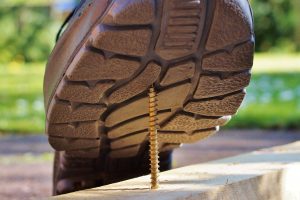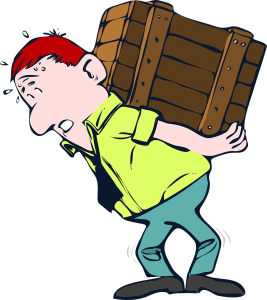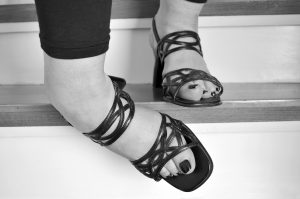Moving to Florida is stressful. From the things that you have to plan, to the people and services that you have to coordinate, there is a lot of incentive to hurry. That’s where most mistakes, and with them, most injuries come from. Doing things properly always takes priority over doing things quickly, and that goes double for moving, where one careless moment can leave you very hurt. And having to postpone the move because of your injury will cost you both in time and finances. So here are a few pieces of advice on how to avoid moving injuries.
Hands, fingers and toes injury
One of the most common things that get injured during a move is hands, fingers, and toes. It’s fairly normal to get splinters while carrying wooden boxes or furniture. And bumping your hands or even dropping heavy things on your toes can happen once you get tired. Also if there are multiple people carrying a heavy object, improper coordination can result in injured limbs.

What can you do to avoid those kinds of injuries?
- Wear proper footwear. Foot injuries can be mitigated if you have protective footwear while moving. Sneakers and boots will protect you much more than slippers. Not to mention the risk of slipping. There is a reason why construction workers wear work boots. The toes on those boots are protected with metal plating. Consider getting them, if possible.
- Protective gloves will help you both with avoiding splinters and having an increased grip. They will also collect moisture from your hands and keep them from slipping.
- Make a clear plan on where and how you are carrying heavy items. Organise with your partner before you start with actual carrying.
- Avoid baggy or restrictive clothes. You will need to be mobile and comfortable.
- Don’t rush or force anything. There are always multiple ways of carrying things, and it may not be clear right away which the right one is.

Back injuries
As people living in the 21st century, we are not used to lifting heavy things. In our everyday lives, the power of our arms is sufficient enough to lift 99% of things. But when we move that 1% pops up. To lift heavier things, instead of using just our arms we need to use our whole bodies, and if we are not properly prepared, injuries occur. And the most common thing that gets injured in that scenario is our back. Strains, pinched nerves, and herniated disks are the most prevalent and, fortunately, most benign injuries and can be properly treated at home. If not careful, you could have serious injuries (like fractured vertebrae) and will probably need surgery. So do a favor for your back and avoid moving injuries.
How to avoid back injuries while moving
- Use proper If you haven’t lived under a rock you’ve heard this. And if you have, somebody told you that you should lift that rock, and this is how to do it. Use your legs. Keep your back straight. And don’t rely on your upper body strength alone. You will need to utilize your whole body if you want to avoid injury.
- To do the right technique you will need the right tools. Consider getting furniture dolly or furniture sliders.
- Know your limits. Again don’t rush into this. If you cannot manage it, call professionals. You are not the Incredible Hulk. It is easy to overestimate yourself if you are not used to using your body and knowing what its capabilities are. Some moving companies offer packing services and you can spend a bit more money to avoid moving injuries and probably stress.

Muscle injuries
Small muscle injuries are fairly common, even in our daily life. At the end of the day, that’s how our muscles grow. We strain them, and they become bigger and stronger. But, as we said moving is very stressful, and that stress isn’t just psychological, it’s also physical and there are limits after which we get injured. If you are not used to lifting heavy things, the sudden weight you put on your muscles may hurt them. The usual injuries include cramps, contusions, and strains (which can go from mild to severe).
How to avoid muscle injury
- Preparation is the name of the game. Getting warmed up before you start lifting heavy object will prepare your muscles and save you from injuries.
- Start slow. If possible, when moving, start with smaller items and gradually move up to heavier ones. It may seem like a good idea to move the heavies stuff right away, while you are still fresh, but that can result in sudden muscle injury.
- Take your time while moving heavy things. Stay hydrated and take regular brakes to freshen up. Don’t force or rush anything. That’s the easiest way to get hurt.
Sprained ankles
Sprained ankles can wary from mild ones where you restore full movement in a matter of hours to severe ones, where the recovery may last for months and that’s if you don’t end up having to have a surgery. Although they are more common in sports where there is a lot of jumping, sprained ankles can occur during a move. Luckily there are ways in which you can reduce the odds of that happening to you.
How to avoid sprained ankles
- Make sure that you are wearing proper footwear. Slipping is the most common way of getting a sprained ankle, and having footwear that has good friction with the walking surface will reduce the risk of injury.
- Clear the path on which you are carrying your items. If you step on something small while carrying something heavy it’s easy to twist or trip and sprain your ankle. Making sure that there are no dangerous items on the way, will prevent from that happening.
- If possible, try to avoid moving on rainy days. Besides the potential of the rain ruining your stuff, you risk slipping on a wet surface. Before you move to check the weather and try to move when its dry. It’s not that much about the temperature as much as it is about humidity that you need to look out for to avoid moving injuries.

